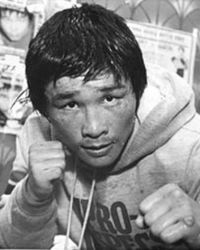
Deuk Koo Kim""Deukoo Kim""
Seoul, South Korea
- Nationality
- South Korea
- Division
- light
- Stance
- southpaw
- Height
- 168 cm
- Reach
- 165"
- Status
- inactive
- Total Bouts
- 20
- Total Rounds
- 122
- Birth Place
- Goseong, South Korea
- Pro Debut
- 1978-12-07
Deuk Koo Kim may not be a household name in the world of boxing, but his tragic story remains etched in the annals of the sport's history. Born on July 29, 1955, Kim was a South Korean professional boxer who competed in the lightweight division during the 1970s. Standing at a height of 168cm and possessing a reach of 165cm, he was known for his southpaw stance, adding a touch of unpredictability to his style.
While Kim may not have had any noteworthy nicknames, his determination inside the ring was admirable. Despite facing numerous challenges throughout his career, he always strived to give it his all, proving his mettle against some formidable opponents.
One of the defining moments in Deuk Koo Kim's career came in the infamous clash with Ray "Boom Boom" Mancini on November 13, 1982. Fighting for the World Boxing Association (WBA) lightweight title, Kim entered the bout as a determined underdog, ready to make a name for himself on the biggest stage.
The fight took place at the outdoor Las Vegas Hilton Sports Pavilion, with a raucous crowd in attendance. From the opening bell, both fighters engaged in a thrilling back-and-forth affair, showcasing their skills and courage. Mancini, known for his relentless pressure and powerful punches, found himself facing the resilient Kim, who refused to back down.
Throughout the bout, Kim displayed heart and resilience, absorbing punishing blows from Mancini while retaliating with his own combinations. However, as the fight progressed into the later rounds, exhaustion started to take its toll on Kim.
Then, tragedy struck in the 14th round. Consumed by fatigue and seemingly out of options, Kim was caught by a powerful right hand from Mancini, sending him crashing to the canvas. Despite his best efforts, Kim was unable to rise before the count of ten, resulting in a technical knockout victory for Mancini.
What followed was a tragic turn of events that would forever change the landscape of boxing. Deuk Koo Kim was rushed to the hospital, where he underwent emergency brain surgery. Tragically, he slipped into a coma and succumbed to his injuries four days later, on November 17, 1982, at the age of 27.
The tragic ending of the Mancini vs. Kim bout sparked a wave of introspection in the boxing community, leading to significant changes in the sport. The fight raised important discussions about fighter safety and the impact of brutal encounters on the long-term health of boxers.
It became a catalyst for reform in the way fights were conducted, prompting revisions to the rules and regulations surrounding the sport. The importance of thorough medical screenings, preventing mismatches, and ensuring fighter safety gained renewed attention, ensuring that tragic incidents like the one involving Deuk Koo Kim would not be forgotten in vain.
Deuk Koo Kim's legacy lives on, serving as a reminder of the inherent risks associated with the sport of boxing. His tragic tale has become a cautionary tale, shedding light on the need for comprehensive measures to safeguard the physical and mental well-being of professional fighters.
Decades after his passing, Kim's story continues to evoke a mixed range of emotions - from shock and sorrow to resilience and reform. It remains a poignant reminder of the sacrifices and dangers that exist in the pursuit of greatness within the squared circle.
As fans of the sport, it is essential to never forget the lessons learned from tragic incidents like the one involving Deuk Koo Kim. Boxing continues to evolve and adapt, striving to strike a delicate balance between the thrill of competition and the safety of its participants.
In honoring the memory of Deuk Koo Kim, we must remain vigilant in our pursuit of a sport that not only captivates us with its athleticism but also protects the warriors who step foot inside the ropes. As the landscape of boxing changes, let us remember the sacrifices made and work towards a future where the safety and well-being of fighters are paramount.